The 9.7" iPad Pro Review
by Brandon Chester on June 1, 2016 9:00 AM ESTDisplay Analysis
The 9.7" iPad Pro has what is by far the most interesting display I've seen on a tablet since the iPad 3, which was the first of the Retina displays. Samsung is arguably the only other vendor making advances with tablet displays, since they're the only company that ships a calibrated AMOLED. However, Samsung has been limited with the brightness they can push on the larger AMOLED displays, and at the end of the day when you set to sRGB the only advantage is the black level when there's not much ambient light to wash the display out.
With the iPad Pro Apple has improved upon the anti-reflective coating that they introduced with the iPad Air 2, and they've moved to a wider color gamut while also implementing a dynamic color feature called True Tone. I'll be talking about True Tone on the next page, but for now I'll be running 9.7" iPad Pro through our standard display workflow, along with an additional test to examine the accuracy within the DCI-P3 color gamut.
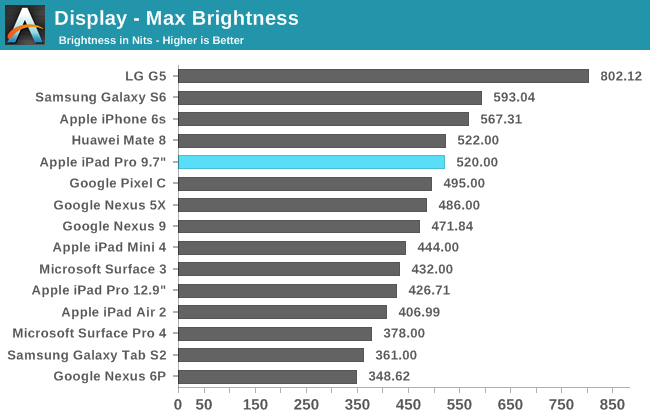
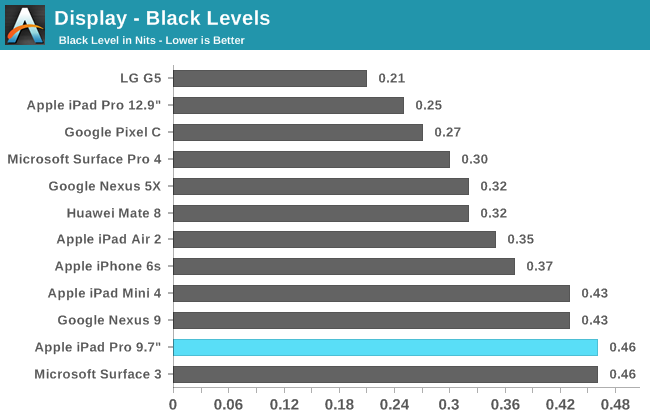
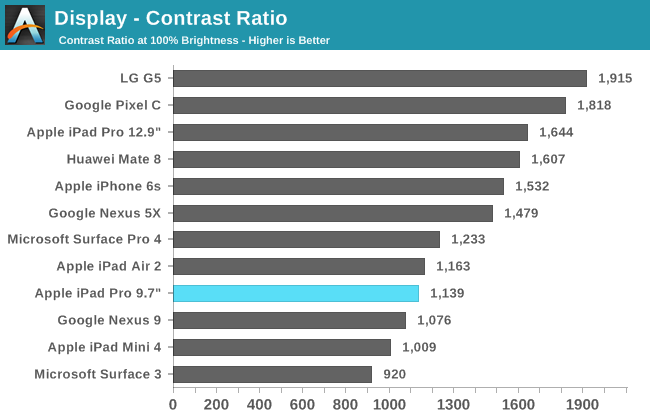
There are two things that I find surprising in the charts above. The first is that Apple actually exceeded their advertised 500 nit brightness. This puts it at the top of our brightness list for tablets, and that's no small feat. Apple's new backlighting array has enabled both a significantly wider gamut and a much higher brightness. Combined with their new anti-reflective coating, the 9.7" iPad Pro handily beats the larger model and the iPad Air 2 as the most usable tablet in bright ambient lighting.
While the 9.7" iPad Pro is quite bright, it doesn't do so well with black levels. Compared to the Pixel C, which has only a slightly lower brightness, the 9.7" iPad Pro's black level is much higher, and the contrast ratio is significantly lower as a result. It's also lower than Apple's 12.9" iPad Pro, and I verified Josh's brightness and black results for the 12.9" iPad against my own to confirm that he didn't just get an exceptional sample. I'm honestly a bit surprised that the gap between the two is so large, as the 9.7" iPad Pro's display is more advanced than the display of the larger model in several respects.
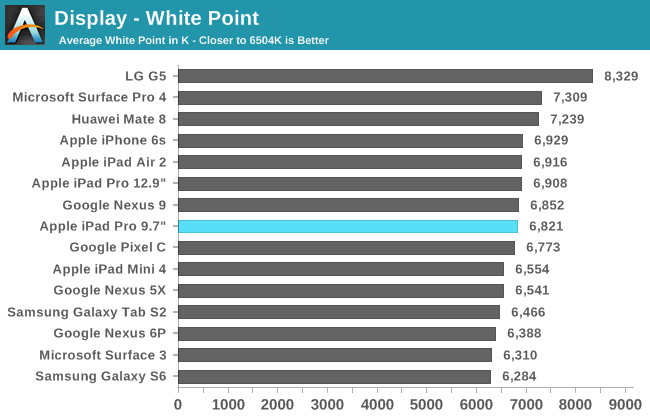

The 9.7" iPad Pro has great greyscale accuracy. Like most of Apple's products, there is a degree of blue shifting, but it's not quite as heavy as on their other products. The gamma is quite straight, and no shade of grey has a DeltaE that hits three, which is generally the goal. The accuracy isn't as high as the iPad Mini 4 which exhibited a surprisingly high degree of accuracy, but beyond the slight blue shift there's not really anything to complain about here.
DCI-P3 Gamut Saturation Sweep
The iPad Pro is Apple's second device that has moved to a wide color gamut. The first was the 2015 iMac with Retina 5K display, and from it we learned a number of things about Apple's implementation. The first thing to make note of is that the display conforms to the DCI-P3 gamut, but it doesn't use the corresponding 2.6 gamma that goes along with the standard. Using that gamma would be a mistake because no content coming on UltraHD Blu-ray is going to use that gamma function, so it's not really an issue in practice. While it remains to be seen how Apple's wide gamut devices will handle content that uses the SMPTE 2084 EOTF, Apple has brought color management to iOS and can transform content that uses a different gamma curve than the 2.2 gamma that the display targets.
Because Apple has implemented color management, they're able to accurately render anything designed for color spaces that sit within the DCI-P3 color space, with the most relevant one being sRGB. For devices with wide color gamuts and color management we'll be testing them against their target gamut and the sRGB gamut for our saturation tests. First up is the DCI-P3 saturation sweep, which uses 20% steps like our sRGB test but obviously targets the wider DCI-P3 gamut and uses Apple's target gamma of 2.2.
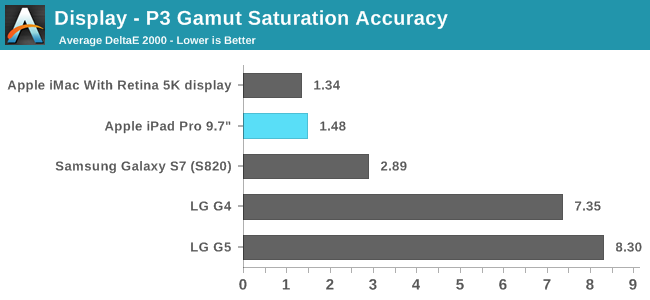
Because only a small group of devices claim to support this color gamut, I don't have as many points of comparison as we usually do. To be honest, the few that we have make it clear that Apple is currently without competition here. The other vendor actively advertising DCI-P3 gamut support is LG, and we've seen that the LG G4 and G5 do not even come close to actually meeting this goal regardless of which gamma target you use. In fact, they're bad enough that Samsung's accurate Adobe RGB mode on the Galaxy S7 accidentally beats them for P3 accuracy here, as it ends up being accurate in areas where the gamuts are very similar and only really has errors along red and with some deep saturations of colors that rely on red or blue.
As for Apple, they're the only vendor that actually covers the red-dependent segment of the gamut and their DeltaE values are incredibly low. The only issue I can see is that green is a bit inaccurate, which seems to be due to the display's blue shift. This is really me looking for criticism though, and with a DeltaE average of 1.48 the only device that beats it is a $2000 iMac.
sRGB Gamut Saturation Sweep
Because each 9.7" iPad Pro is individually calibrated, the color profile included is essentially a perfect description of the physical display's characteristics and color output. Because of this, the profile can be used to map colors from the sRGB color space to the display's native gamut with a high degree of precision, which is only limited by the display's color depth. In fact, this potentially allows for greater accuracy than if the display had been calibrated against the sRGB gamut in the first place, as the small error levels in Apple's calibration are accounted for by the profile and when doing color transformations.
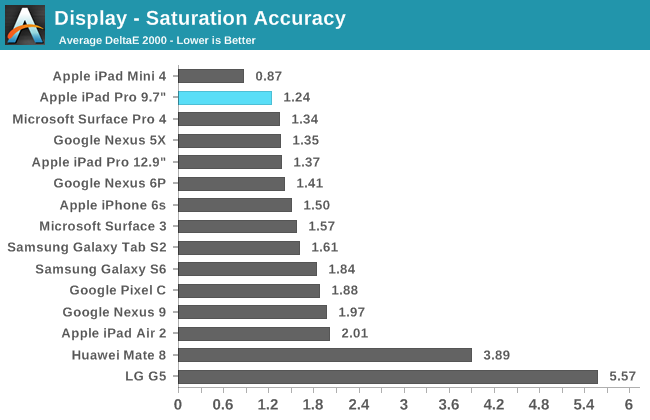
When displaying content designed for the sRGB gamut, the 9.7" iPad Pro is incredibly accurate. It's actually more accurate than the already near-perfect P3 results, with the red, blue, and green primaries being even closer to their target values. The only color that ever has an error above two is 20% saturated yellow, and the largest error is actually white which as we saw earlier is a bit too blue. Aside from those, every color has a DeltaE below two, and many are around or even below one. There's honestly not much more Apple could do here; this really is a professional-grade display.

As one would expect, the 9.7" iPad Pro has no trouble rendering the color mixtures from the GretagMacbeth ColorChecker test. The largest errors are actually the greyscale shades, and none of the DeltaE values for colors actually go above two. It's worth noting that the colors in this test are defined such that they should always be the same regardless of the color space, and so the fact that I've targeted sRGB has no change on the test outcome. For reference, changing the target to the P3 gamut produced an average DeltaE of 1.56, and I did that test at a later time so the error is well within the bounds of errors relating to the position of the meter on the display and the small inherent measurement error of the i1Pro 2 itself. This is a good example of Apple's color management at work, as my untagged image files were correctly inferred as having been created with the sRGB color space in mind, and transformed into the display's native gamut.
As far as tablet displays go, the 9.7" iPad Pro has the best one that I've seen. The combination of greatly improved peak brightness, extremely good color accuracy, an improved anti-reflective coating, and support for a wider color gamut all contribute to this, and the usefulness of aspects like the wide gamut will become even more apparent as time goes on and more content supporting it is released.



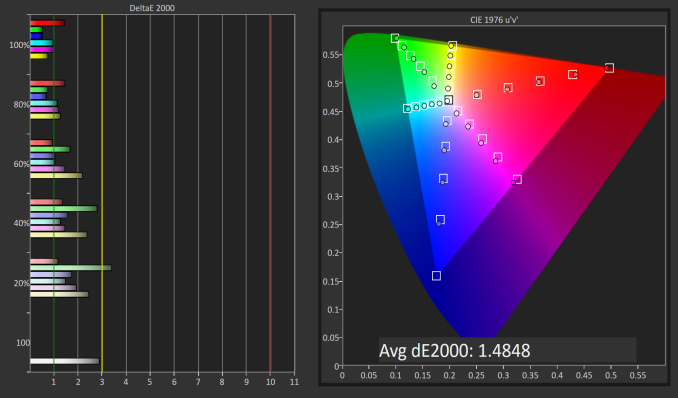
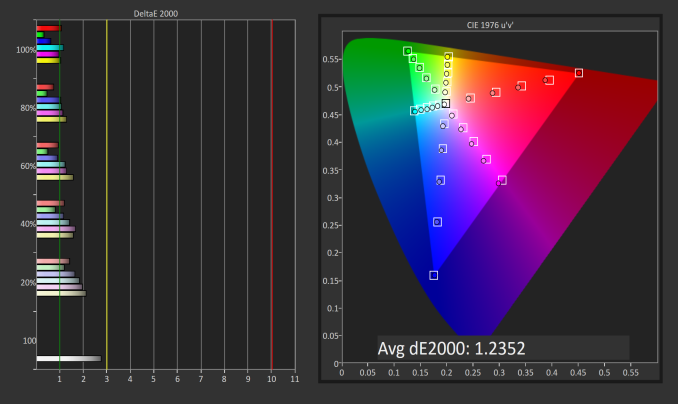
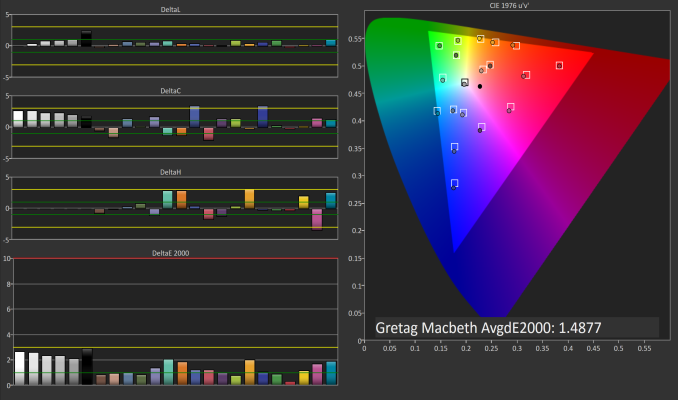








144 Comments
View All Comments
The Garden Variety - Wednesday, June 1, 2016 - link
For the love of god: Stop it. Stop putting spaces between the end of your sentence or clause and your punctuation. I realize the French in particular insist on doing this because, well, they're French, but that doesn't change the fact that for written English it is completely and entirely wrong. If you want to be taken seriously, be serious. Write like you care, not like a third grader. English not your first language? Fair enough, but then consider this your first step toward being taken more seriously in your communication.Brandon Chester - Wednesday, June 1, 2016 - link
The question mark with spaces on both sides reminds me of the conditional operator in C :)kurahk7 - Wednesday, June 1, 2016 - link
Keep in mind that each of these publications only have a sample size of one, and that there are variances between the same products. Because of that, Displaymate might have received an iPad with a slightly worse calibration/panel than Anandtech and vice versa for the Surface.BadSimian - Wednesday, June 1, 2016 - link
Displaymate on the iPad Pro's screen - "It is by far the best performing mobile LCD display that we have ever tested, and it breaks many display performance records." http://www.displaymate.com/iPad_Pro9_ShootOut_1.ht...Deelron - Wednesday, June 1, 2016 - link
"Since departure of Anand, Apple product reviews look like PR marketing speech, although the tests and content itself of the review do not match the speech"Amusing since so many reviews by Anand on Apple products had the exact same refrain in the comments.
Wolfpup - Wednesday, June 1, 2016 - link
Huh? Apple's CPUs have been years ahead of the ARM stuff available for Android for...years. Swift was a nice A9+ just like Krait, but since the year after (2012) their CPUs have just been massively far ahead...and yet I STILL hear comments like this that seem completely unaware of that.zepi - Wednesday, June 1, 2016 - link
Amoled doesn't mean infinite contrast in practice, only in pitch black test environment. In real life blackest signal is (reflectance) x (ambient light), not zero. Due to this, in high ambient light new iPad has better blacks than any amoled display on the market.And actually, if we go to signal processing maths and measurements, we could start drawing comparisons from them. No one in their right mind would try to argue that 16-bit CD quality audio has infinite dynamic range, even though it is very easy to sample total silence in form of zero signal value to a musical track.
Also music volume is not considered to be infinite, but the value is compared to arbitrarily defined human hearing threshold and converted to logarithmic decibels with 0 meaning non-zero value at the lowest level human ear can measure.
One pretty reasonable comparison point for amoled contrast might be using the quantization error at lower end of the brightness. Ie: something along the lines of set brightness of display to max, display uniform pictures of gray at RGB(1,1,1), measure this brightness in lumens, divide by two (this is quantization error for lowest measurable signal) and then use this as a divisor for the highest recorded value for RGB(255,255,255). Depending on gamma, dividing by two gives wrong results, but for linear display this would be ok.
Infinitely linear displays are available ACME shop just next to frictionless bearings and other such very handy things...
UtilityMax - Monday, June 6, 2016 - link
I suspect iPad Pro is compared with the flagship android smartphones because Android tablet hardware sucks. Just have a look at the Galaxy Tab S2 or the Pixel C.tecsi - Wednesday, June 1, 2016 - link
Any chance of including iPad Air benchmark numbers as many of we iPad Air owners want to understand the performance gains we can expect.I assumed I could just look at your iPad Air 2/iPad Air reviews to get those numbers there, but apparently your benchmarks are different as the iPad Air 2 Kraken 1.1 numbers were different in the two reviews.
Please let us know if you can do this.
Ryan Smith - Wednesday, June 1, 2016 - link
Unfortunately we do not have the original Air, so we are unable to generate any new numbers for it.